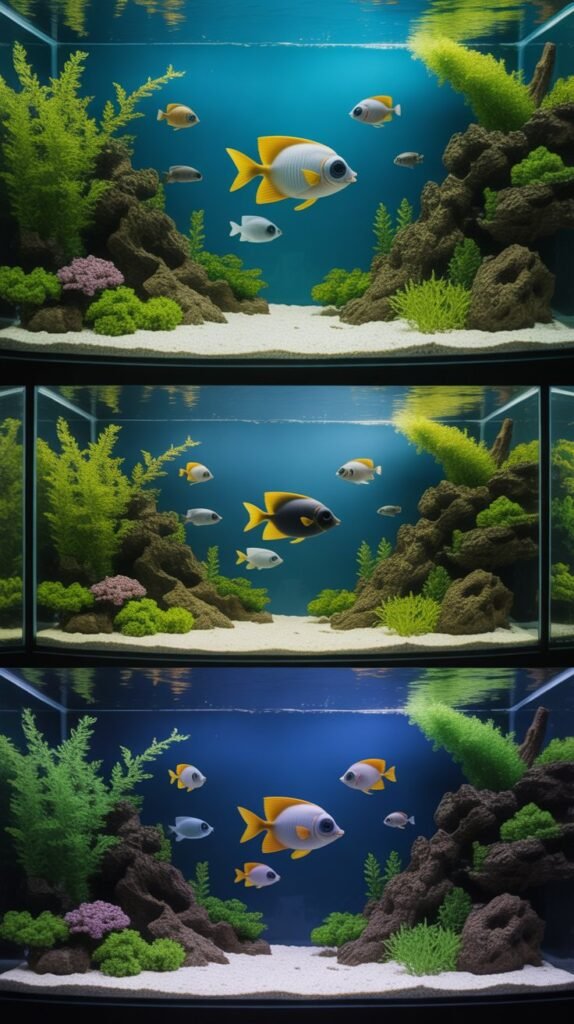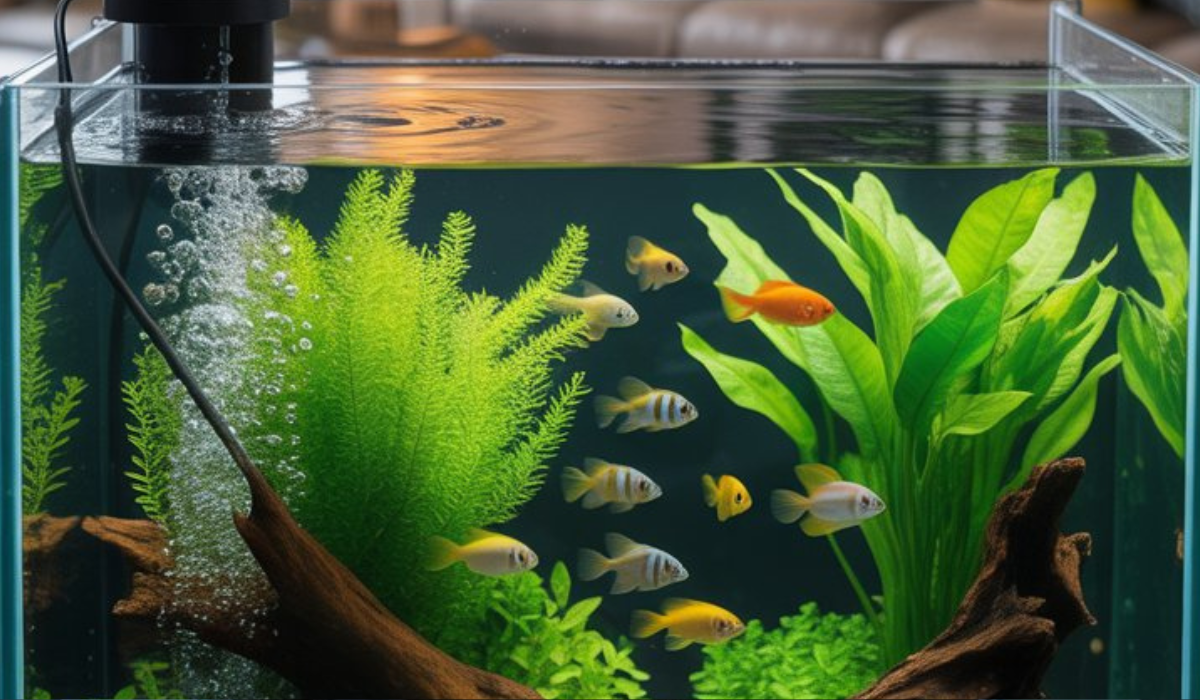Setting up an aquarium is exciting, but before adding fish, there’s one crucial step that determines whether your aquatic environment thrives or fails — aquarium cycling. Many beginners skip this step and end up with sick or dying fish due to poor water quality.
In this detailed guide, we’ll explore what aquarium cycling is, why it’s so important, how to cycle your aquarium correctly, and how to maintain a healthy nitrogen cycle for the long term.
What Is Aquarium Cycling?
Aquarium cycling (also known as the nitrogen cycle) is the process of establishing beneficial bacteria that break down toxic waste products in your tank. When fish produce waste or leftover food decomposes, harmful substances like ammonia and nitrite are released.
Cycling helps create colonies of nitrifying bacteria that convert these toxins into nitrate, a much less harmful compound that can be removed through regular water changes.
In simple terms, aquarium cycling is nature’s way of making your tank safe for fish. It mimics the biological filtration found in natural bodies of water, keeping your aquarium environment balanced and stable.
Why Aquarium Cycling Is Essential
If you skip cycling, your fish are exposed to toxic ammonia and nitrite spikes that can quickly kill them. Even if they survive, poor water quality will cause stress, disease, and stunted growth.
Here are the top reasons why cycling your aquarium is vital:
- Prevents Fish Deaths:
Uncycled tanks contain toxic compounds that burn fish gills and damage organs. - Creates a Stable Environment:
Beneficial bacteria maintain balance by processing waste continuously. - Promotes Fish Health:
Proper cycling ensures fish experience less stress, live longer, and show brighter colors. - Reduces Maintenance Effort:
Once your tank is cycled, you’ll need fewer water changes and less frequent cleaning. - Prevents Algae Blooms:
Balanced water chemistry reduces excess nutrients that fuel algae growth.
Understanding the Nitrogen Cycle in Aquariums

Step 1: Ammonia Production
When fish excrete waste or uneaten food decomposes, ammonia (NH₃) is released into the water. Even a small amount of ammonia (as low as 0.25 ppm) can be deadly.
Step 2: Nitrosomonas Bacteria Convert Ammonia into Nitrite
Over time, beneficial bacteria called Nitrosomonas develop in your filter and substrate. They consume ammonia and produce nitrite (NO₂⁻) — which is still toxic to fish.
Step 3: Nitrobacter Bacteria Convert Nitrite into Nitrate
A second group of bacteria called Nitrobacter or Nitrospira then converts nitrite into nitrate (NO₃⁻). Nitrate is far less harmful and can be controlled with water changes and plants.
Step 4: Water Changes Remove Nitrate
Nitrate builds up over time. To keep levels safe (below 40 ppm), you must perform regular partial water changes.
This biological process is continuous — once established, it keeps your aquarium stable indefinitely, as long as you maintain it properly.
How Long Does Aquarium Cycling Take?
The cycling process typically takes 4 to 8 weeks depending on several factors:
- Temperature
- Filter efficiency
- Tank size
- Presence of live plants or starter bacteria
You’ll know your tank is fully cycled when:
- Ammonia = 0 ppm
- Nitrite = 0 ppm
- Nitrate = 5–40 ppm
You can measure these levels using an aquarium test kit, which helps you track progress weekly.
Methods of Aquarium Cycling
There are two main methods: fishless cycling and fish-in cycling. Let’s look at both.
1. Fishless Cycling (Recommended)
This method is the safest and most ethical. You add an ammonia source without any fish, allowing bacteria to grow naturally before introducing fish.
Steps for Fishless Cycling:
- Set Up the Aquarium
- Install your filter, heater, and air pump.
- Add substrate, decorations, and plants.
- Fill with dechlorinated water.
- Add an Ammonia Source
- Use pure household ammonia (without additives) or fish food that will decompose to release ammonia.
- Test Ammonia Levels
- Aim for 2–4 ppm ammonia concentration.
- Wait for Nitrite to Appear
- After a few days to a week, beneficial bacteria start converting ammonia to nitrite.
- Monitor Nitrite Levels
- Once nitrite appears, continue testing daily. Eventually, nitrates will begin to form.
- Wait Until Ammonia and Nitrite Reach Zero
- When both are 0 ppm and nitrates rise, your tank is fully cycled.
- Perform a Large Water Change
- Reduce nitrate levels before adding fish (about 50% water change).
- Introduce Fish Slowly
- Add a few hardy fish at first and increase stocking gradually.
2. Fish-In Cycling
This method involves adding a few fish to start the cycle. It’s more stressful for the fish, so it requires careful monitoring.
Steps for Fish-In Cycling:
- Choose Hardy Fish
- Species like zebra danios, mollies, or guppies are ideal starters.
- Feed Sparingly
- Overfeeding increases ammonia levels. Feed lightly once per day.
- Monitor Water Parameters Daily
- Use test kits to check ammonia, nitrite, and nitrate.
- Perform Frequent Water Changes
- Replace 25–50% of the water whenever ammonia or nitrite exceeds 0.5 ppm.
- Add Beneficial Bacteria Starter (Optional)
- Commercial bacterial supplements can speed up cycling.
- Once Stable, Add More Fish Gradually
- Wait until ammonia and nitrite remain at zero for at least a week before adding new fish.
Factors Affecting the Aquarium Cycling Process

Several conditions influence how fast and effectively your tank cycles:
1. Temperature
Bacteria grow faster in warm water (between 75–85°F or 24–29°C).
2. Oxygen Levels
Good aeration and surface movement promote bacterial growth.
3. Filter Media
Porous materials like sponge or bio balls provide surface area for bacteria to colonize.
4. Ammonia Source
Consistent ammonia levels are needed for bacteria to thrive.
5. Water Conditioner
Use only dechlorinated water, as chlorine or chloramine can kill beneficial bacteria.
6. Plants
Live plants absorb ammonia and nitrate, helping stabilize water chemistry.
Signs That Your Aquarium Is Fully Cycled
You’ll know your aquarium is ready for fish when:
- Ammonia: 0 ppm
- Nitrite: 0 ppm
- Nitrate: Detectable (10–40 ppm)
- Water Clarity: Clear and odor-free
- Stable pH and Temperature
At this stage, your tank has developed a healthy colony of bacteria, and you can safely introduce fish without risking ammonia poisoning.
What Happens If You Don’t Cycle Your Aquarium?
Skipping the cycling process can lead to what’s commonly known as “New Tank Syndrome.”
Here’s what happens:
- Ammonia levels spike rapidly.
- Fish show signs of stress — gasping at the surface, clamped fins, or erratic swimming.
- Nitrite follows, causing oxygen deprivation.
- Fish may die within days.
Cycling prevents this by establishing a natural filtration system before adding fish.
Speeding Up the Aquarium Cycling Process
If you want to shorten the cycling time, here are some proven methods:
- Use Filter Media from an Established Tank
- Transfer sponge or bio media from a mature tank to seed your new one with beneficial bacteria.
- Add Live Plants
- Fast-growing plants like hornwort, water wisteria, and anacharis absorb ammonia and support bacterial balance.
- Use Bacterial Supplements
- Products containing live nitrifying bacteria can jumpstart the process.
- Keep Temperature Optimal
- Maintain water between 77–82°F (25–28°C).
- Ensure Strong Aeration
- Beneficial bacteria need oxygen to thrive.
- Avoid Cleaning or Changing Filter Media
- Never rinse your filter with tap water during cycling; it kills bacteria.
Maintaining the Nitrogen Cycle Long-Term

Cycling doesn’t end once your aquarium is established. You must maintain the balance to keep your tank healthy.
1. Regular Water Changes
Replace 20–30% of the water weekly to keep nitrate levels under control.
2. Clean Filters Carefully
Rinse filter media only in tank water during maintenance.
3. Avoid Overfeeding
Excess food increases ammonia levels.
4. Monitor Parameters Weekly
Use a liquid test kit to check ammonia, nitrite, and nitrate regularly.
5. Don’t Overcrowd Your Tank
Too many fish produce excess waste that overwhelms the bacteria.
6. Keep Plants Healthy
Live plants act as natural nitrate filters and oxygen sources.
Common Problems During Aquarium Cycling
Even with care, beginners may face challenges. Here’s how to troubleshoot them:
Problem 1: Ammonia Spike
Cause: Overfeeding or too many fish early.
Solution: Do immediate 50% water change and reduce feeding.
Problem 2: Nitrite Plateau
Cause: Insufficient bacteria converting nitrite to nitrate.
Solution: Add bacterial supplement or seed filter media.
Problem 3: Cloudy Water
Cause: Bacterial bloom — normal in early stages.
Solution: Wait it out; it clears in a few days as balance stabilizes.
Problem 4: pH Drop
Cause: Accumulated waste or low buffering capacity.
Solution: Perform partial water changes and use a pH stabilizer if needed.
Problem 5: Slow Cycle
Cause: Low temperature or lack of oxygen.
Solution: Increase temperature slightly and improve aeration.
Aquarium Cycling Myths
Let’s debunk some common misconceptions:
- Myth 1: “I can cycle my tank in a day with conditioner.”
Truth: Conditioners only detoxify ammonia temporarily — they don’t establish bacteria. - Myth 2: “Live plants replace cycling.”
Truth: Plants help, but bacterial colonies are still essential for long-term stability. - Myth 3: “You can add all your fish at once after cycling.”
Truth: Add fish gradually to avoid overwhelming the bacterial population. - Myth 4: “Changing all the water resets the cycle.”
Truth: Bacteria mostly live in the filter and substrate, not the water itself.
Best Fish to Start a Newly Cycled Aquarium
Once cycling is complete, start with hardy, beginner-friendly fish:
- Guppies
- Zebra Danios
- Mollies
- Platies
- Corydoras Catfish
- White Cloud Mountain Minnows
Introduce a few at a time to avoid sudden ammonia increases.
Conclusion
Cycling your aquarium is the foundation of a healthy, thriving aquatic ecosystem. It ensures that harmful waste products are processed safely, protecting your fish and maintaining balance in your tank.
Whether you choose the fishless or fish-in method, patience is key. Don’t rush the process — let nature take its course. Once your tank is fully cycled, your fish will live in a stable, toxin-free environment where they can grow and flourish.
By following proper cycling steps, monitoring water quality, and maintaining your nitrogen cycle, you’ll create a sustainable home for your aquatic pets for years to come.
FAQs About Aquarium Cycling
1. What does it mean to cycle an aquarium?
Cycling an aquarium means establishing beneficial bacteria that convert toxic ammonia and nitrite into safe nitrate, creating a balanced environment for fish.
2. How long does aquarium cycling take?
Typically 4 to 8 weeks, depending on temperature, filter type, and bacterial growth rate.
3. Can I cycle my aquarium with fish inside?
Yes, but it’s more stressful for the fish. Frequent water changes and careful monitoring are required.
4. What is the fastest way to cycle a tank?
Use bacterial starters, seeded filter media from an established tank, and maintain warm temperatures (77–82°F).
5. How do I know my tank is fully cycled?
When ammonia and nitrite levels are 0 ppm, and nitrate levels are detectable but low (10–40 ppm).
6. Can plants help cycle an aquarium?
Yes, live plants absorb ammonia and nitrate, speeding up cycling and stabilizing the ecosystem.
7. Do I need to cycle a new tank every time I change water?
No. Once cycled, bacteria remain in the filter and substrate, so regular water changes don’t reset the cycle.
8. Can I add all fish at once after cycling?
No. Add fish gradually to allow the bacterial colony to adjust to increased waste.
9. Why are my fish dying in a new tank?
Likely due to ammonia or nitrite poisoning from an uncycled or partially cycled tank.
10. Does aquarium cycling ever end?
No. The nitrogen cycle continues forever — it’s a natural, ongoing process that keeps your aquarium healthy.

